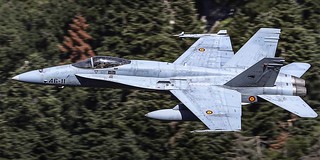The F-35A of the 65th AGRS: US stealth fighters that pretend to be Russian and Chinese fighters
For half a century, the training of fighter pilots in the United States has been carried out through the use of attack squadrons.
These squadrons, operating in both the United States Air Force (USAF) and the United States Navy and Marine Corps, imitate the aerial tactics used by potential hostile aircraft (mainly Chinese and Russian) to train American pilots in close air combat, known as "dog lights". Aggressor squadrons usually bring their planes decorated in a similar way to Russian and Chinese fighters, so that American pilots get used to identifying them.
Just one year ago today, the first stealth fighter joined those attacking squadrons, specifically the Lockheed Martin F-35A Lightning II, the version used by the USAF. Those first two aircraft were attached to the 65th Aggressor Squadron (65th AGRS) , based at Nellis AFB (Nevada). The purpose of these attack planes is to imitate the Russian Sukhoi Su-57 and the Chinese Chengdu J-20, both of which are stealthy aircraft (at least theoretically) used by rival US powers. USA Military Channel today released a video showing images of these aggressor aircraft :
You can see below some photos of these aircraft published by the USAF. Here we see one of the F-35As of the 65th AGRS (11-5020) at Nellis AFB on June 9, 2022, taxiing around the base platform to make the first training flight with these planes. Prior to the addition of the F-35A, the 65th AGRS had successively used A-7D Corsair II attack aircraft and F-5E Tiger II and F-15C Eagle fighters for these missions. The other two USAF Aggressor squadrons, the 18th AGRS and the 64th AGRS, currently use F-16 fighters.

The F-35A are one of the few planes of this type that have a camouflaged fuselage, since these stealth fighters normally keep the gray paint from the factory, a paint that has anti-radar features. Here we see one of the F-35As of the 65th AGRS (11-5021) on its first flight with this squadron on May 26, 2022.

A photo of F-35A 11-5021 on its maiden flight with the 65th AGRS. In the background we can see several of the F-16s of the 64th AGRS, with decorations that also mimic Russian and Chinese aircraft.

Lt. Col. Brandon Nauta, 65th AGRS commander aboard an F-35A on June 9, 2022. The pilot wears the sophisticated Helmet Mounted Display System (HMDS) helmet strong>, which has the integrated HUD (Head-Up Display). That's why the F-35s lack that classic glass screen over their control panels.

Two F-35A Lightning IIs of the 65th AGRS fly alongside two F-15E Strike Eagle fighter-bombers on June 9, 2022, over the barren Nevada landscape, during a training flight. The image allows us to see the difference in size between the two aircraft: the F-15E measures 19.43 meters long, compared to 15.67 meters for the F-35A.

A photo of the first two F-35As of the 65th AGRS, 11-5021 (foreground) and 11-5020 (behind). There are plans to add some F-22 fighters to this attacking squadron as well, as the F-16s and F-15s do not have the characteristics of modern stealth fighters and do not provide as realistic training as possible against modern aircraft with a very low radar signature.

The drifts with the initials WA of the first two F-35As of the 65th AGRS , the 11-5021 and the 11-5020. The 65th AGRS was deactivated on September 26, 2014 when its F-15Cs were withdrawn from service. The squadron was officially reactivated on June 9, 2022. This unit has a long history dating back to its founding in 1940 under the name of the 65th Pursuit Squadron, which was like the Air Corps of the The US Army (then the USAF did not yet exist) then called its fighter squadrons.

|
Don't miss the news and content that interest you. Receive the free daily newsletter in your email: |
- Most read
- Spain will modernize its fleet of firefighting seaplanes and buy seven new DHC-515s
- Sierra Army Depot, a huge United States base with hundreds of Abrams tanks stored
- A former secret submarine base in Estonia and its important role in the Cold War
- United States' last Hueys: Vietnam-era veterans still flying in the US Air Force
- Eurofighter vs F-35: the opinions of professional pilots on these advanced fighters
- A spectacular video of an Alpha Scramble with Eurofighter aircraft from Spain and Germany
- Lampart, the new camouflage that the Polish Army is testing for its uniforms

 ES
ES







Opina sobre esta entrada: